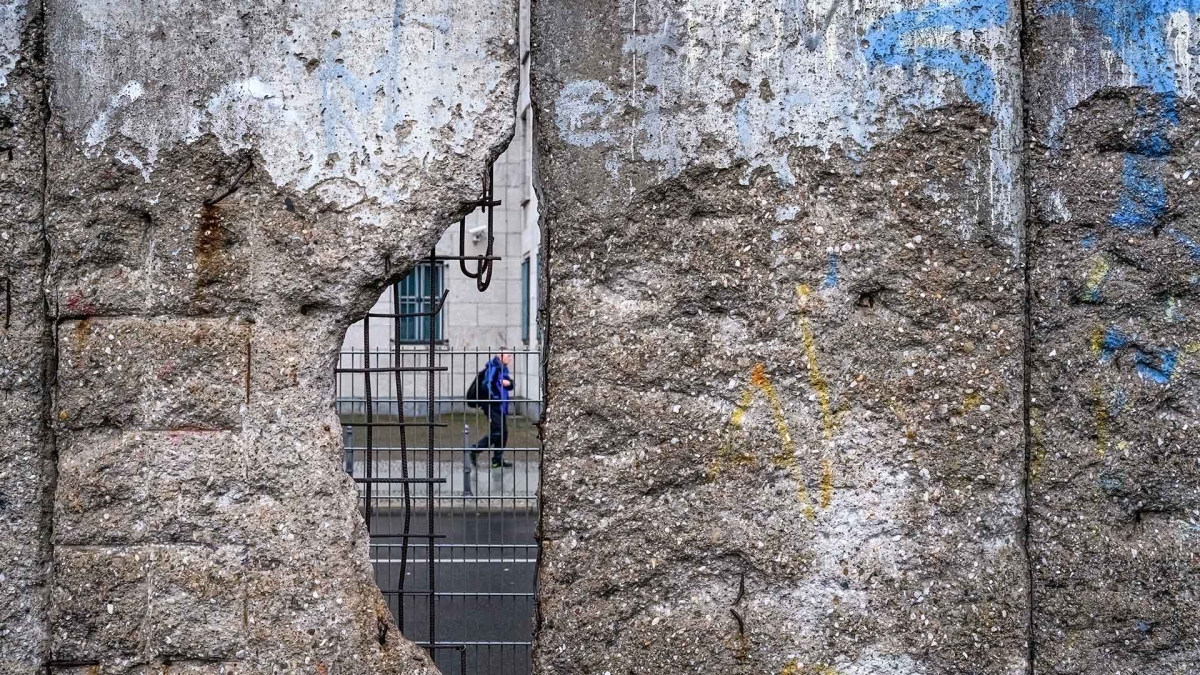Why Did the Berlin Wall Fall? A Story of Change, Hope, and Unity
- Why Did the Berlin Wall Fall? A Story of Change, Hope, and Unity
- FAQ About Berlin Wall
- Who built the Berlin Wall and why?
- Why did the Berlin Wall fall?
- What was the Wall in Berlin for?
- Why was Berlin split in half?
- What are 5 facts about the Berlin Wall?
- How many people died at the Berlin Wall?
- Why did Germany split after WWII?
- Why didn't people go around the Berlin Wall?
- Can you visit the Berlin Wall?
- Why did Nikita Khrushchev build the Berlin Wall?
- Why did Russia get East Germany?
- Why was Germany split into two countries?
- Which side of Berlin was communist?
The Berlin Wall, a symbol of division and political tension, stood for nearly 30 years, separating not just a city, but families, friends, and entire nations. Its fall in 1989 wasn’t just the end of a physical barrier; it marked a turning point in global history, one that would bring Germany back together and change Europe forever.
So, why did the Berlin Wall fall? The answer is wrapped in political shifts, grassroots movements, and the powerful human desire for freedom.
The Divided City: A Barrier Between Worlds
After World War II, Germany was divided between the victorious Allies: the Soviet Union, the United States, Great Britain, and France. Berlin, though located in East Germany, was also split into East and West sectors. This division soon became more than just geographical—it became a stark contrast between two worlds: the communist East and the capitalist West.
The Berlin Wall, erected in 1961 by East Germany’s government, was meant to prevent the mass emigration of East Germans to the West. Over time, it came to embody the ‘Iron Curtain’ Winston Churchill famously described, dividing families, friends, and a nation.
One of the harshest realities was the forced separation of families. Many East Berliners, like Ingrid Wenzke, hadn’t seen their loved ones for decades. When the Wall fell, Ingrid was one of the many who rushed to the border to reunite with her sister after 28 years. Their tearful embrace symbolized the deep emotional wounds inflicted by the Wall.
A Desire to Escape: Risking It All for Freedom
East Germans lived under an oppressive regime, and many sought to escape to the West at any cost. Between 1961 and 1989, over 5,000 people attempted daring escapes, scaling the Wall, digging tunnels, and finding any way to freedom. Some succeeded, but many paid the ultimate price.
- Peter Fechter, an 18-year-old bricklayer, tried to flee in 1962 but was tragically shot by East German border guards and left to die in the death strip. His death became a haunting symbol of the dangers faced by those who sought freedom.
- The famous Tunnel 57 escape in 1964 saw 57 East Berliners successfully smuggled to the West through a secret tunnel. Such escape attempts carried immense risks, with families facing imprisonment, surveillance, or worse.
What Led to the Fall?
Throughout the 1980s, tensions between East and West began to ease, and political, social, and economic pressures mounted within East Germany. A series of pivotal events contributed to the eventual collapse of the Wall:
- 1985: Gorbachev’s Reforms
Mikhail Gorbachev, leader of the Soviet Union, introduced reforms like glasnost (openness) and perestroika(restructuring). These changes sparked hope for more freedom across the Eastern Bloc, inspiring East Germans to demand reform. - 1989: The Power of Protests
Mass protests broke out across East Germany, particularly in Leipzig, where over 70,000 people marched, demanding freedom of movement and democratic rights. These protests became impossible for the government to ignore. - November 9, 1989: The Announcement That Changed Everything
In one of history’s most surreal moments, East German official Günter Schabowski mistakenly announced at a press conference that travel restrictions would be lifted immediately. This miscommunication led thousands of East Berliners to flood the Wall, demanding to be let through. Overwhelmed, the guards opened the gates, and just like that, the Berlin Wall fell.
What Was Happening Meanwhile?
As the Wall fell, the world watched in awe. Live broadcasts captured emotional scenes of East and West Berliners hugging, celebrating, and tearing down sections of the Wall with their hands. It was a moment few believed they would witness in their lifetime.
Behind the scenes, political negotiations were taking place across Europe. The fall of the Wall marked not only the end of the Cold War but the beginning of a new era of democracy and openness. Germany, once divided, began the complex process of reunification. On October 3, 1990, East and West Germany officially became one country again.
The Outcome: Reunification and Beyond
The fall of the Berlin Wall had far-reaching consequences, not just for Germany but for the entire Eastern Bloc. It signaled the collapse of communist regimes across Eastern Europe, with countries like Poland, Hungary, and Czechoslovakia transitioning towards democracy and market economies.
For Germans, reunification came with its own set of challenges. The economic disparities between East and West needed to be addressed, and social integration was an ongoing process. But the joy of reunification, the sense of being whole again, outweighed these hurdles.
The Wall: More Than Just a Barrier
Today, remnants of the Berlin Wall stand as reminders of a painful past and a hopeful future. Walking through Berlin, you can visit the Berlin Wall Memorial and sense the powerful energy of a city once divided but now united.
The Wall, once a symbol of division, is now a testament to resilience and the human spirit’s desire for unity and freedom.
- The Berlin Wall was erected in 1961 to prevent East Germans from fleeing to the West.
- Political reforms, grassroots protests, and a mistaken announcement led to the Wall’s fall on November 9, 1989.
- The fall of the Wall marked the end of the Cold War and paved the way for German reunification on October 3, 1990.
- Today, the remnants of the Berlin Wall stand as symbols of freedom and unity, reminding us of a world that once was and how far we’ve come.
The Berlin Wall was more than just bricks and mortar—it represented a dark period in history when people were divided by ideology, geography, and politics. But its fall shows the enduring power of hope, change, and the unbreakable human will to be free.
FAQ About Berlin Wall
Who built the Berlin Wall and why?
The Berlin Wall was built by the German Democratic Republic (East Germany) in 1961. The wall was erected to stop the mass emigration and defection from the Eastern Bloc to the West, as many East Germans were fleeing to West Berlin and beyond for better opportunities and freedoms.
Why did the Berlin Wall fall?
The Berlin Wall fell in 1989 due to a combination of factors including mounting pressure from East German citizens, the weakening of Soviet control over Eastern Europe, and increasing political reforms within East Germany. The opening of the wall was also hastened by a miscommunication about new travel regulations.
What was the Wall in Berlin for?
The Berlin Wall was a physical barrier separating East Berlin (controlled by the Soviet-backed East German government) from West Berlin (a free city surrounded by East Germany). It was intended to prevent East Germans from fleeing to the West and to stop the flow of refugees from the East.
Why was Berlin split in half?
Berlin was split in half after World War II as a result of agreements between the Allied powers (the United States, the Soviet Union, the United Kingdom, and France). The city, located in the Soviet occupation zone of Germany, was divided into East and West Berlin, mirroring the division of Germany into East and West.
What are 5 facts about the Berlin Wall?
- The Berlin Wall was approximately 155 kilometers (96 miles) long when it was complete.
- It was built overnight on August 13, 1961, with barbed wire fences initially and later reinforced with concrete.
- The wall had watchtowers and was heavily guarded by East German border troops.
- Around 5,000 East Germans managed to escape to the West despite the wall’s barriers.
- The fall of the Berlin Wall on November 9, 1989, symbolized the end of the Cold War and led to German reunification.
How many people died at the Berlin Wall?
Approximately 140 to 200 people died attempting to cross the Berlin Wall from East to West Berlin. Many of these deaths were due to gunfire, traps, or accidents while trying to escape.
Why did Germany split after WWII?
Germany split after World War II due to differing ideologies and interests among the Allied powers. The U.S., U.K., and France occupied the western zones, forming West Germany with democratic governance, while the Soviet Union controlled the eastern zone, establishing East Germany under communist rule.
Why didn’t people go around the Berlin Wall?
While some attempted to circumvent the Berlin Wall, the wall was fortified with guard towers, barbed wire, and a “death strip” filled with obstacles designed to prevent escapes. Additionally, East Germany was surrounded by a network of border controls and checkpoints, making it difficult to find alternative routes.
Can you visit the Berlin Wall?
Yes, you can visit several remaining sections of the Berlin Wall and associated museums. Notable sites include the East Side Gallery, the Berlin Wall Memorial at Bernauer Strasse, and Checkpoint Charlie, which offer historical information and preserved segments of the wall.
Why did Nikita Khrushchev build the Berlin Wall?
Nikita Khrushchev, the Soviet Premier, did not personally build the Berlin Wall, but he supported its construction as a means to prevent East Germans from fleeing to the West. The wall was intended to stop the brain drain and economic losses that were affecting East Germany due to the mass emigration of its citizens.
Why did Russia get East Germany?
Russia, or more accurately, the Soviet Union, controlled East Germany as part of its sphere of influence in Eastern Europe after World War II. The division of Germany into East and West was a result of agreements among the Allied powers, with the Soviet Union overseeing the eastern zone.
Why was Germany split into two countries?
Germany was split into two countries after World War II due to the geopolitical tensions between the Soviet Union and the Western Allies. The division resulted in the formation of the Federal Republic of Germany (West Germany) and the German Democratic Republic (East Germany) in 1949, reflecting the broader Cold War divide.
Which side of Berlin was communist?
East Berlin was the communist side of Berlin. It was controlled by the German Democratic Republic (East Germany) and was part of the Soviet bloc, whereas West Berlin was a free city surrounded by East Germany and was supported by the Western Allies.
How informative was this article?
Click on a star to rate it!
We are sorry that this post was not useful for you!
Let us improve this post!
What is missing in the article?















